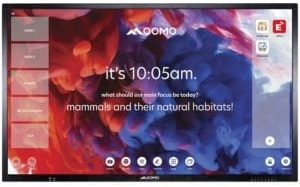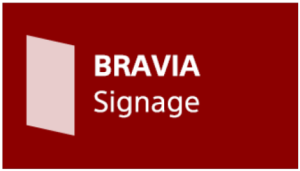Sony WQ-BS1 BRAVIA Signage Professional Displays User Guide
SONY WQ-BS1 BRAVIA Signage Professional Displays User Guide
Introduction
This guide describes the following. If you are a first-time user of BRAVIA Signage, read the “BRAVIA Signage Startup Guide” first.
- Setup of BRAVIA Signage
- Initial setup
- Version update
- Uninstallation
- Signage Operations with Operation Web Application
BRAVIA Signage Setup
This section describes the setup of the server and display. The overview of the procedure is as follows:
- Server (Setup for BRAVIA Signage Server)
- Display (Setup for BRAVIA Signage Player)
- Installation of BRAVIA Signage Player (Required)
- Display settings (Optional)
- Pre-shared key settings (Optional)
- BRAVIA Signage Player setup (Required)
Server PC Setup (BRAVIA Signage Server)
Refer to chapter 4 in “BRAVIA Signage Startup Guide”.
Install BRAVIA Signage Player
Refer to chapter 4 in “BRAVIA Signage Startup Guide”.
Confirm Display Settings
Refer to chapter 4 in “BRAVIA Signage Startup Guide”.
Configure Pre-Shared Key
BRAVIA has Pre-shared Key as a configuration. This configuration restricts the applications without Pre-Shared key to control power on/off, reboot and so on. You can configure Pre-Shared Key to BRAVIA Signage with config.txt described in “Appendix IV. config.txt specification” of [help] of upper right of Operation Web Application.
- Network > Home Network > IP control > Authentication
Set “Pre-Shared Key” - Network > Home Network > IP control > Pre-Shared Key
Set key
If you use this feature, configure display and BRAVIA Signage Player with the following procedures:
- Change display to Hotel/Pro setting mode. Refer to the BRAVIA B2B HTML5 Solution Technical Manual to set the Hotel/Pro Setting Mode.
- Configure display settings as the above.
- Change display to Hotel/Pro Mode.
- Edit the “pre-shared key” of config.txt as a key value in procedure [2] Configure BRAVIA Signage Player with the config.txt. Note that when BRAVIA Pre-Shared Key value does not match with “pre-shared-key” of config.txt, no error message is displayed on the display because the BRAVIA Signage Player cannot start.
Configure BRAVIA Signage Player
Configure and Start BRAVIA Signage Player
Refer to chapter 4 in “BRAVIA Signage Startup Guide” for this procedure, and refer to “Appendix IV. config.txt specification” of [help] of upper right of Operation Web Application. about the detail of config.txt used for the configuration.
Stop and Restart BRAVIA Signage Player
- Push [HOME] button of remote controller and select the following application icon displayed on HOME screen of the display.

- The configuration starts as seen in the diagram below. Select [Stop], push [OK], and BRAVIA Signage Player stops.
The configuration starts also when executing the same procedure as above while BRAVIA Signage Player stops. When selecting [Start] and pushing [OK], BRAVIA Signage Player starts to run again.
In addition, when inserting a USB flash memory with config.txt to the display USB port while the display is powered ON, the configuration starts. This operation can be used instead of the procedure [1] above.
Change the configurations of the BRAVIA Signage Player
Display configurations can be changed when inserting a USB flash memory with config.txt updated to change the configurations to the display USB port. In that case, “override” key must be “true” in config.txt. In addition, only the display name can be changed from [Display Management] page of Operation web application, and refer to [help] of upper right of Operation web application about this procedures.
Update and Uninstall BRAVIA Signage
This section describes the update and uninstalling of BRAVIA Signage. The overview of the procedure is as follows:
- Update BRAVIA Signage
- Update BRAVIA Signage Server (Required)
- Update BRAVIA Signage Player (Required)
- Uninstall BRAVIA Signage
- Uninstall BRAVIA Signage Server (Required)
- Uninstall BRAVIA Signage Player (Required)
In addition, BRAVIA Signage Server and BRAVIA Signage Player check their versions against each other at connection in order to run properly. Connection is allowed only in the following cases.
- BRAVIA Signage 1.7.3 or earlier is used and the BRAVIA Signage Server version is the same as BRAVIA Signage Player.
- BRAVIA Signage 1.7.4 or later is used, and the BRAVIA Signage Player version is the same as or earlier than BRAVIA Signage Server.
Update BRAVIA Signage Server
In this section, the update procedure of MongoDB and BRAVIA Signage installed on the server is explained. The information registered on the older version of BRAVIA Signage Server is over written in this update.
- Copy the “windows” folder in the package on any directory in your Server.
- Right-click “setup.bat” in this “windows” folder and select “Run as administrator”. The following window is displayed:
If the directory path name includes half width letters such as ‘@#$%^&()_+~-=`{}[]’, the above screen cannot be displayed depending on the combination of these letters. If the screen does not display, please confirm the directory path name. - Input “2” and push the “ENTER” key in this window as seen in the following diagram, the MongoDB installation window is displayed as seen in the following diagram, and update in accordance with the guidance.
- After the update of MongoDB, the configurations are automatically executed. The BRAVIA Signage Server installation window is displayed as seen in the following diagram and update in accordance with the guidance.
- After the update of BRAVIA Signage Server, the configurations are automatically executed.
- Push the “ENTER” key to close the window.
- Double-click the following shortcut icon created on the desktop.
When double-clicked, Operation Web Application opens with your browser on your server.
Update BRAVIA Signage Player
This section describes how to update BRAVIA Signage Player in display.
- Copy “extapp_installer.pkg” in the package on the root directory in the USB flash memory.
- Turn on display and insert the USB flash memory to a USB port on the display.
- As the installer starts, update this application following the installer’s instructions.
- At next, copy “extapp_installer.pkg” under BRAVIASignageLauncher folder to the root folder in the USB flash memory.
- Execute same procedures as above [2] and [3].
- After update, configure BRAVIA Signage Player with config.txt. Refer to 1.5. Configure BRAVIA Signage Player for details.
NOTE Don’t turn off or unplug display during the installation. It may cause display to breakdown.
Uninstall BRAVIA Signage Server
In this section, the uninstallation procedure to remove installations and configurations on the server is uninstalling. The information registered to BRAVIA Signage Server is not removed by uninstalling.
- Copy the “windows” folder in the package with the same version as the installed version on any directory in you Server.
- Right-click “setup.bat” in this “windows” folder and select “Run as administrator”. The following window is displayed:
If the directory path name includes half width letters such as ‘@#$%^&()_+~-=`{}[]’, the above screen cannot be displayed depending on the combination of these letters. If the screen does not display, please confirm the directory path name. - Input “3” and push the “ENTER” key in this window as seen in the following diagram and the installed and configured content are automatically removed.
- If the window of “Microsoft Visual C++ 2015 Redistributable(x64)” is displayed during the uninstallation, push the [uninstall] button to uninstall.
- After the uninstallation of “Microsoft Visual C++ 2015 Redistributable(x64)”, push the [close] button.
- The uninstallation messages for BRAVIA Signage Server, Apache, and MongoDB are displayed as seen below:
- Push the “ENTER” key to close the window.
- As in the previous descriptions, the information registered to BRAVIA Signage Server is not removed by uninstalling. If the information is unnecessary, manually remove the data as seen below:
- the information saved in MongoDB: “C:\data” directory
- the log and contents in Apache : “C:\Apache24” directory
Uninstall BRAVIA Signage Player
This section describes how to uninstall BRAVIA Signage Player in display.
- Copy “extapp_installer.pkg” with the same version as the installed version in the package on the root directory in the USB flash memory.
- Turn on display and insert the USB flash memory to a USB port on the display.
- As the installer starts, uninstall this application following the installer’s instructions.
- At next, copy “extapp_installer.pkg” with the same version as the installed version in the package under BRAVIASignageLauncher folder to the root folder in the USB flash memory.
- Execute same procedures as above [2] and [3].
NOTE Don’t turn off or unplug the display during the installation. It may cause the display to breakdown.
Notice and Information
This section describes the notice and information on BRAVIA Signage setup.
- Downgrading of BRAVIA Signage
In the current and earlier versions, BRAVIA Signage does not support downgrades. If downgrades are performed using an earlier installer than your current version, information including your playlist and schedules will not be supported. - Installation after BRAVIA Signage Player uninstallation
In 1.7.2 or later, if you want to install BRAVIA Signage Player after unintalling it, you need to configure with config.txt that “override” key is “ture”. If it is not “true”, the configuration from before uninstalling BRAVIA Sinage Player is taken over.
Signage Operations with Operation Web Application
You can open the guide from [help] of upper right of Operation Web Application. Refer to the guide on how to use Operation Web Application.
Change History
- All: Modify the missing descriptions and described expressions, designs.
- Chapter 1
- Move conventional descriptions about config.txt to help page.
- Move conventional descriptions to related procedures and descriptions.
- Chapter 2
- Change procedures due to additional feature.
- Change procedures due to additional feature.
- Chapter 4 and 5
- Move conventional descriptions to related procedures and descriptions.